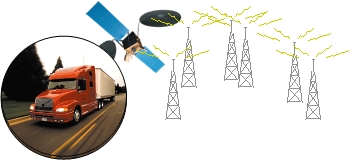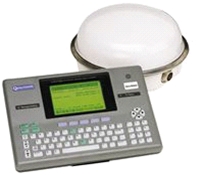Objective Satellite- and cellular-based mobile two-way communication tracking systems for commercial motor vehicles wirelessly emit, transmit, and receive information to track vehicles and facilitate communications between drivers and carrier personnel. |
Description  Wireless mobile communications tracking systems use satellite-tracking Global Positioning System (GPS) technology for vehicle location information, as well as satellite and/or cellular communications technologies for two-way communication. Satellite-based mobile communications systems use a network of orbiting satellites to provide two-way communication coverage between a carrier and its assets, while cellular-based systems utilize a land-based or terrestrial network of cellular base stations/towers. Some systems utilize a combination of satellite and cellular communications by automatically selecting the lower-cost cellular network first and seamlessly switching to the satellite network when coverage is needed in remote areas. A communications satellite is a radio relay station in orbit above the earth that receives, amplifies, and redirects analog and digital signals carried on a specific radio frequency. Communications data pass through a satellite using a signal path known as a transponder. Vehicles are typically equipped with a terminal containing a transceiver and antennas for location determination and communication, which relay information via satellite to an earth station. From the earth station, the information is sent along landlines or retransmitted via satellite to the carrier's operation center and vice versa. Cellular-based mobile communication systems use land-based cellular towers in service areas divided into many different cells for communication coverage. As a user/driver travels out of the range of one cell, he or she is automatically transferred to a different cell, if available. Information is relayed from the cellular network along landlines to the carrier's operation center and vice versa.  Using these systems, carrier personnel and drivers remotely communicate with each other; in addition to, transmitting and receiving various types of data. Most mobile communications tracking systems include a driver interface unit installed in a cab for two-way text communications. Yet, recently released systems can relay information in the form of voice and text. For example, one system has a text-to-speech capability that allows drivers to hear and replay messages without pulling over to stop and look at the terminal. Using a computer interface, such as an Internet accessible reporting system, carrier personnel send and receive messages and view position information to track vehicles en route. For many systems, vehicle positions can be automatically displayed at a regular frequency determined by the carrier. Wireless mobile communications tracking systems may be integrated with other technologies, such as carriers' back office dispatching systems and vehicle surveillance systems. Some systems provide driver and vehicle information, such as driver hours-of-service logs and automated maintenance data. For example, one system interfaces directly with a vehicle's sensor inputs or the on-board data bus to provide information at specified intervals in the form of individual driver performance reports and automatic data such as, engine speed, vehicle speed, and idling time. This data can be displayed to the drivers, and carriers can assess whether or not driving behaviors are meeting company-set parameters. Another system is integrated with video cameras and an on-board data recorder to wirelessly transmit vehicle data, as well as event information outside of the vehicle. Many systems include a proximity alert geo-fencing feature, which automatically notifies carriers when trucks enter and depart a user-defined area. Dispatchers or fleet operators can create a geo-fence, which is a defined electronic boundary made up of geo-coded points for particular vehicles or routes. If a vehicle enters a restricted geo-fenced area, or exits the defined areas, the carrier personnel can be alerted to take appropriate action. In addition, these systems can be utilized in conjunction with routing services, which have the capability to relay re-routing information. One routing service offers real time re-routing around congested areas due to roadwork, crashes, or other incidents. Certain wireless communications tracking systems can be purchased with a tethered trailer tracking unit mounted on the trailer, to provide visibility into trailer connection and disconnection events. Using one system, a dispatcher can receive trailer position information along with the date and time of the trailer connection and disconnection event over the satellite communications link. Furthermore, the driver display unit also displays the identification number of the trailer connected to the tractor, which allows the driver to verify that his or her tractor is connected to the correct trailer.  Additional features of several systems are panic buttons that relay alerts in emergency situations and vehicle disabling systems that remotely prevent the operation of a vehicle. For example, emergency alerts can be relayed by a driver to carrier personnel using a panic button mounted inside the vehicle on the dashboard or a wireless panic button key fob to remotely send an emergency alert to the carrier. Some wireless panic buttons can be activated up to 100 feet from the vehicle, triggering an emergency panic message that can be transmitted to a carrier's email, pager, or phone. Typical messages provide the date, time, and position of the tractor when the panic button was activated. Possible limitations of wireless mobile communications tracking systems include loss of signal, obstructions within the path of a satellite signal, or undetected equipment problems. Application Using mobile communications tracking systems, drivers, dispatchers, and fleet managers can easily communicate during daily operations and emergencies. These systems allow on-site carrier personnel to efficiently send messages, such as load assignments, directly to the drivers in near-real-time. Then, drivers can send messages to dispatchers and respond with current information, such as arrivals and departures. In addition, the systems can provide on-site carrier personnel with vehicle location information, such as latitude, longitude, and distance from cities, towns, and landmarks. Some systems display the last known locations and position history information of vehicles. As a result, dispatchers know when vehicles are expected to arrive at destinations, and they can relay this information to their customers. By assessing vehicle locations along with operating parameters, carriers can track driver and vehicle performance to conduct more efficient and safe operations. By wirelessly communicating routing information, specific routes can be pre-determined and last minute route changes can be conveyed to drivers to improve delivery times. In addition the geo-fencing feature provides alerts to the carrier when a vehicle departs from a set route for appropriate action to be taken. Operations and Benefits The use of mobile communications tracking systems can enhance the safety, security, and efficiency of commercial vehicle operations by providing information about asset locations and a direct means of communication between carrier personnel and drivers. To increase security, these systems allow drivers to make real-time contact with carrier personnel in emergency situations. By closely tracking vehicles and assets, opportunities for cargo and vehicle theft can be reduced. Additional benefits include potential improvements in delivery service and asset utilization through vehicle location and routing information. Human resource management and worker productivity can be enhanced by carriers receiving more accurate status and arrival time information on shipments. Increased visibility into this information can expedite deliveries and help to ensure on-time performance to customers. Furthermore, implementation of mobile communications tracking systems with tethered trailer tracking units have the potential to maximize vehicle utilization and facilitate better trailer inventory management. Overall, this information allows carriers to improve scheduling of deliveries. The use of mobile communications tracking systems can improve safety when operational maintenance personnel remotely diagnose vehicle operating parameters to maintain optimum vehicle safety and minimize repair expenses. In addition, safer operations can result from the carrier using information from these systems to monitor driving performance. Increased safety, security, and efficiency also have the potential to lower costs to carriers. Cost The installed cost of wireless mobile communications systems depends upon the type of system that is purchased and the type of installation that is required. Cellular-based mobile communications systems with various features range in cost from $500 to $1,000 for hardware and $15 to $45 per month depending on usage. Satellite-based mobile communications systems with various features range in cost from approximately $1,000 to $4,000 for hardware with monthly fees running from $25 to $80 per month depending on usage. Some plans include a flat fee, while others are based on a flat fee in addition to per-message or air-time usage fees. This price does not reflect the price of servers and dispatch systems, which can vary depending on the customers. The inclusion of various other sensors to the system incurs additional costs. The systems can be installed by the manufacturer or experienced technicians utilizing detailed manufacturer guidelines. Vendors AirIQ Inc.
1099
Kingston Road, Suite 233
Pickering, ON Canada L1V
1B5
Phone: 905-831-6444
Toll Free:
888-606-6444
http://www.airiq.com | Air-Trak,
Inc.
11353 Sorrento Valley Road
San Diego, CA
92121
Phone: 858-677-9950
Fax:
858-677-9959
Toll Free: 877-247-8725
http://www.air-trak.com | Evicam International Incorporated
(Surveillance System)
9482 S.Garden Court
Littleton, CO 80126
Phone: 303-913-3888
http://www.evicam.com | Fleetilla
1745 Fritz Drive
Trenton, MI 48183
Phone: 734-699-6153
http://www.fleetilla.com | GPSManagement
480 Northfield Drive, Suite 500
Brownsburg, IN 46158
Phone: 800-914-8247
http://www.gpsmanagement.com | PAR Logistics Management Systems
5152 Commercial Drive East
Yorkville, NY 13495
Phone: 315-738-0600 ext:846
http://www.parlms.com | QUALCOMM Incorporated
5775 Morehouse Drive
San Diego, CA 92121-1714
Phone: 858-587-1121
http://www.qualcomm.com/qwbs/ | Safefreight Technology (USA) Inc.
8000 N.E. Parkway Drive
Suite 200
Vancouver, WA 98662
Phone: 360-256-1280
Fax: 360-397-0167
http://www.safefreight.com | XATA Corporation
965 Prairie Center Drive
Eden Prairie, MN 55344
Phone: 1-800-745-9282
www.xata.com | Satellite Security Systems, Inc. (S3)
6779 Mesa Ridge Road
Suite 100
San Diego, CA 92121
Phone: 858-638-9700
http://www.satsecurity.com | Teletrac
Corporate Office
7391 Lincoln Way
Garden Grove, CA 92841-1428
Phone: 714-897-0877
Fax: 714-379-6378
http://www.teletrac.net | Telogis
85 Enterprise, Ste 450
Aliso Viejo, CA 92656 U.S.A.
Phone: 1-949-389-5500
Fax: 1-866-422-4096
Toll Free: 1-866-TELOGIS (835-6447)
http://www.telogis.com |
Disclaimer The information provided in these guides about products and services available from private entities does not constitute an endorsement by the Federal Motor Carrier Safety Administration (FMCSA) of the views expressed by any non-Federal entity, or its products or services. FMCSA is publishing lists of vendors on this site solely in an effort to further public awareness of vendors identified as possible contacts for further information and possible purchase of different types of safety and security equipment. The list of vendors is not a complete list. The information in these product guides is disseminated by FMCSA in the interest of information exchange. The United States Government assumes no liability for the contents or use of these guides. These guides do not constitute standards, specifications, or regulations, and FMCSA provides no assurance that the listed vendors and their products and services meet applicable standards, specifications, or regulations. Links to Web sites outside the U.S. Government or the use of trade, firm, or corporation names within FMCSA's Web site are solely for the convenience of the user. Users who select a link to a non-government Web site leave the FMCSA Web site, and are subject to the privacy and security policies of the owners/sponsors of those Web sites. FMCSA does not control or guarantee the accuracy, relevance, timeliness, or completeness of information on a linked non-government Web site. FMCSA cannot authorize the use of copyrighted materials contained in linked Web sites. Users must request such authorization from the sponsor of the linked Web site. FMCSA is not responsible for transmissions users receive from linked Web sites. FMCSA does not guarantee that outside Web sites comply with Section 508 (accessibility requirements) of the Rehabilitation Act.

|